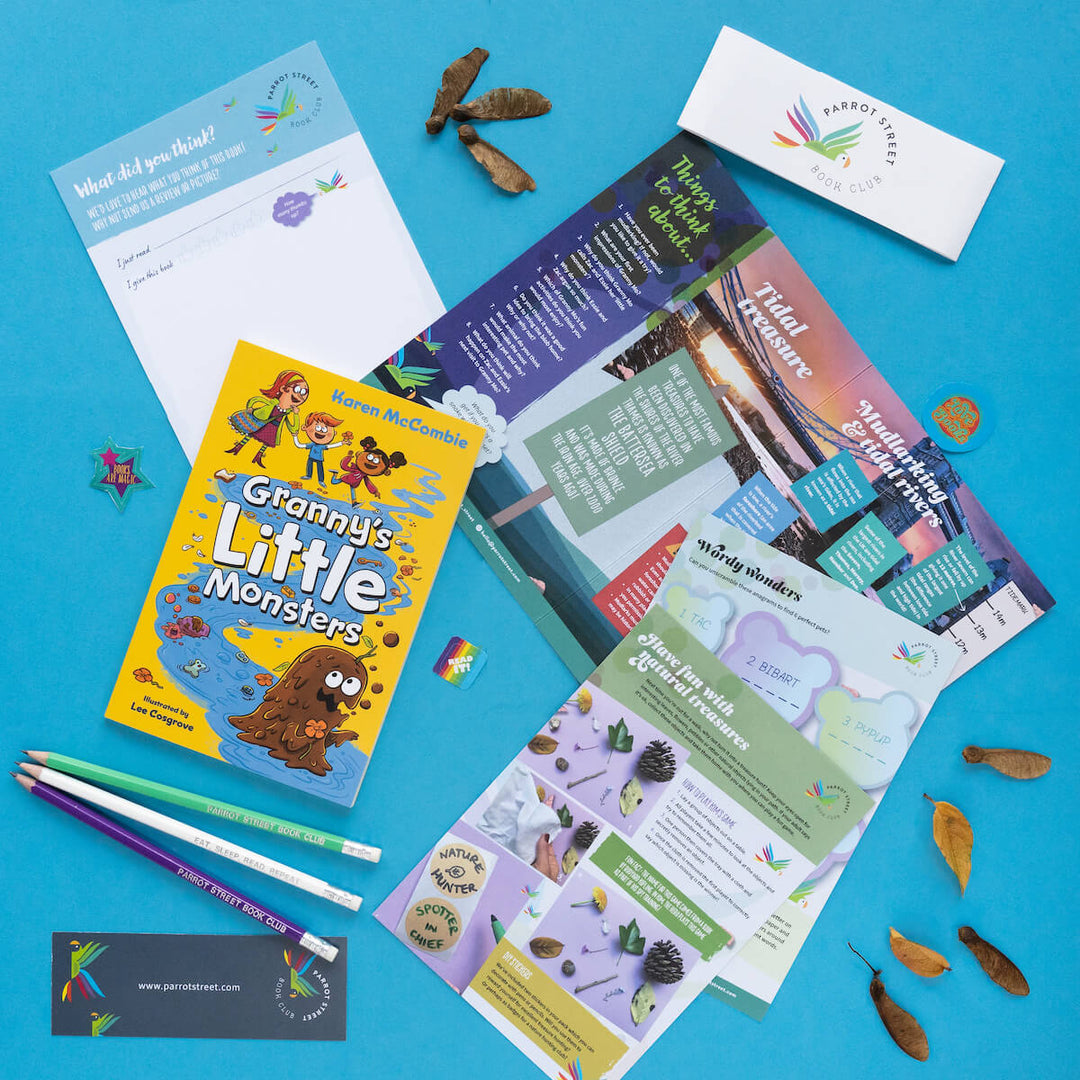Peter Burns on Shadow Thieves and the best books for tweens and early teens

The second book we've sent our Macaw subscriber this month is Shadow Thieves, the thrilling new novel by Peter Burns. This gripping story, which is perfect for fans of Harry Potter and Percy Jackson, follows a group of tweens into an alternative world of thieves, assassins, politicos and spies where they unravel secrets, face incredible danger, and discover the true meaning of friendship. Packed with suspense, heart, and a touch of the supernatural, Shadow Thieves is ideal for young readers who love adventure with depth. Here Peter tells us about what inspired the book and shares some of his favourite reads for tweens and early teens — books that inspire imagination, empathy, and courage.
What inspired you to write Shadow Thieves?
The idea first came to me when I was on holiday in Highland Perthshire, around ten years ago. I was staying in the middle of nowhere, surrounded by gorgeous mountains and thick forests of pine and fir trees and I remember thinking, ‘Wouldn’t it be cool if there was a secret school here – for criminals.’
The idea marinated for a long time. Eventually the location for the school moved from Scotland to the Alps. That school became four schools dotted around the world, with each one teaching a different criminal discipline – how to be a Thief, a Spy, an Assassin or a Politico. The graduates from these schools go on to work for an international criminal organisation called the Shadow League.
The tone and action of the of books are, without doubt, inspired by the films and books I watched and read as a child: James Bond, Indiana Jones, the Goonies, classic boarding school capers and golden age murder mysteries. I suppose you could say that the books are Harry Potter (without the magic) meets Oliver Twist in Lyra’s Oxford.
In what ways would you say the political background of story is relevant today?
Without wanting to encourage conspiracy theories, the idea of shadowy organisations secretly controlling politicians, political discourse and political action have long captured the imagination of certain segments of society. In recent years the concept of ‘the deep state’ and other malign forces being the true wielders of political power in western governments has taken increasingly profound hold, while, conversely, certain individuals in positions of power have openly worked to enrich themselves, their family and their friends instead of focussing their energies on positively impacting the lives and fortunes of their citizens and global allies. I could easily write a whole book examining parallels – both real and imagined – around this theme, but it’s probably best to stop here!
We were struck by what the book says about class and community. What do you hope young readers will take away from the story and how it unfolds?
Class, community and the concept of identity (and the impact of colonialism) are central themes that I wanted to explore in the book – and throughout the series. Tom is oblivious to his own history; he has no known blood relatives, no one to tell him who he is or where he’s from. Without these, he has to create a new family and forge an identity entirely of his own making. He has a father figure in Morris and brothers and sisters in the kids from the warehouse in London, but in different ways he loses each of them and is forced to form new bonds – always developing who he is as a person. As he moves from London to the Alps, he not only has to confront myriad challenges on his journey to become a Shadow Thief, but he also has to confront how people see him: an outsider, seemingly inexplicably plucked from the detritus of society. He has to deal with being thrust into a world of extreme wealth, privilege and powerful dynasties and prove his worth if he is not only to thrive in this new life, but survive it. Danger is everywhere – and not just physically; he has to take care to remember who he is and why he is doing what he is now doing, never forgetting that he has worth, even when others tell him he has none.
Can you tell us anything about what the future holds for Tom?
A lot of action, danger and adventure! Tom and his friends travel to deadly and sinister locations all around the world, meeting terrible enemies and obstacles. Hopefully readers will take huge satisfaction as the breadcrumbs laid in book one are carried into the remaining instalments in the series and these breadcrumbs are paid off one by one. As a taster, we’re off to an abandoned island in the Mediterranean in book two (called Death’s Head Island), on the hunt for a lost treasure and a legendary weapon that might change the fate of the world.
Why did you choose to write books for this age group?
It’s the genre and age-group that I’ve always wanted write for, ever since I was child. It’s just taken me forty-odd years to finally do it successfully! As an adult, these are the stories that I love to share with my own children, whether it be books, audiobooks or family films and I adore the escapism of the worlds conjured for this age group.
Do you have a favourite place to write?
The beauty of being a writer is that you can do it anywhere as long as you have a pen and paper, a laptop or a phone (it’s wild how much writing I do on the notes app of my phone). But my main spot is a little office at home packed with books and I love tucking myself away in there and disappearing into Tom’s world.
Which other stories would you recommend our subscribers read next?
I would heartily recommend Jonathan Stroud’s Scarlett & Browne series (and anything at all by him, to be honest), with the concluding part of the trilogy just published (The Legendary Scarlett & Browne). Alexander Armstrong’s Evenfall: The Golden Linnet has also been a favourite of mine in the last year; I’m sure all your subscribers will be fans of Katherine Rundell’s Impossible Creatures and A.F. Steadman’s Skandar series, but if they’ve yet to dive into those, they shouldn’t wait another minute. And while Philip Pullman is most famous for His Dark Materials series, another absolute favourite of mine are his Sally Lockhart books – how’s this for an opening of the first instalment to get the pulse racing:
On a cold, fretful afternoon in early October, 1872, a hansom cab drew up outside the offices of Lockhart and Selby, Shipping Agents, in the financial heart of London, and a young girl got out and paid the driver.
She was a person of sixteen or so – alone, and uncommonly pretty. She was slender and pale, and dressed in mourning, with a black bonnet under which she tucked back a straying twist of blond hair that the wind had teased loose. She had unusually dark brown eyes for one so fair. Her name was Sally Lockhart; and within fifteen minutes, she was going to kill a man.
Would you rather attend a school for thieves, assassins, politicos or spies and why?
I suppose I need to do a process of elimination here. I’ve got mangled fingers from playing rugby for years, so I’m probably not dexterous enough to be a Thief; I’m not morally bankrupt enough to be a Politico; I’m not psychotic enough to be an Assassin; so I’m going to lean into my love of James Bond and the fact my grandmother was a codebreaker at Bletchley Park, and I’ll head off to the Culper Intelligence Station in New Avignon to begin my journey to become a Spy.
Copies of our Shadow Thieves pack, including a copy of the book and loads of fun activities to go with it, are now available for individual purchase. Grab a copy while stocks last!
This post includes affiliate links to our bookshop.org page, meaning we receive a small percentage of the sale should you purchase through them. Additionally, a percentage from all sales on the platform goes directly to local UK bookshops which is an initiative we're delighted to support!
JOIN OUR EMAIL LIST
Children's book news straight to your inbox
We love sharing product updates, book recommendations, children's activity ideas and special offers via email.














